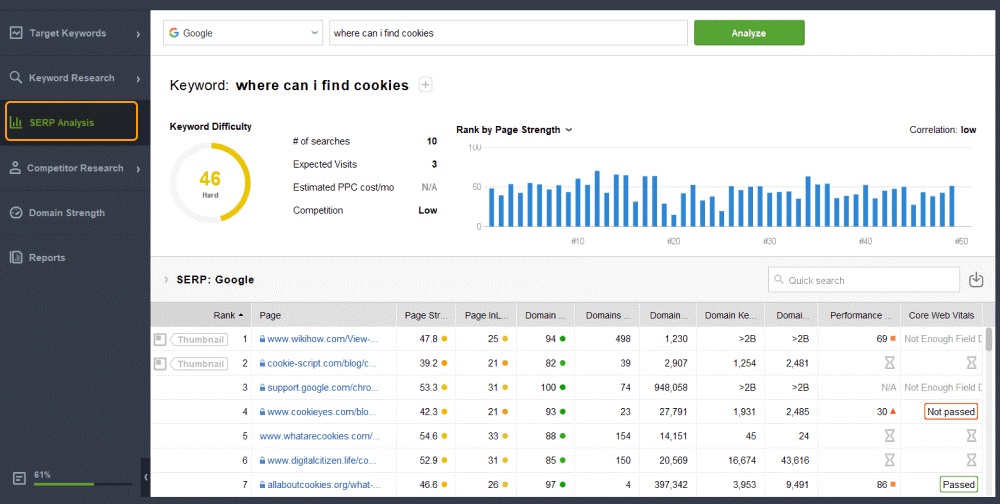
Every new optimization project starts with keyword research. A thorough analysis of the SERP (search engine results page) for each query helps identify opportunities and challenges in the niche. How to analyze competitors, what tools to use, and how SEO metrics let you channel your efforts in the right direction – learn in this ultimate guide to competitive SERP analysis.
What is SERP analysis?
Competitive SERP analysis implies doing step-by-step research of your organic competitors, by the end of which you will have a list of great content opportunities for your website.
A basic analysis of your SERP competitors comes down to the following steps:
- Finding your target keywords.
- Researching the competitive landscape.
- Investigating your top organic competitors.
- Analyzing the factors that help your competitors rank.
To put matters simple, you will need to answer several questions that will help you define what kind of content to create. These questions are:
- What is the search intent of your query?
- What pages from the top of the SERP best satisfy this intent?
- How do competitors attain good rankings? In other words, how do they optimize their content, and what best SEO practices do they use?
After you’ve walked through the whole competitive analysis process, you will have ideas for optimizing the content so that your pages appear on top of the SERPs. You will also have estimates of potential traffic that the keywords will bring.
How to identify your best traffic keywords?
Keyword analysis starts with researching more terms around the seed keyword.
A seed keyword is usually the brand name, the main product, or the basic description of the marketing niche. Usually, we look for more keywords by using automatic suggestions on Google and related searches.
An important thing to know about a keyword is to understand its search intent, a purpose that a person has in mind while looking for the word. The type of search intent predetermines what content type will match the query. There are a lot of intent subtypes, but the most distinctive are:
- Informational intent: the searcher wants to learn some information for whatever reason; it corresponds to creating awareness about the subject; informational queries are vague, short-tail, containing only a couple of words.
- Investigational intent: the searcher investigates different sides of the subject or explores it in detail; queries with commercial search intent often start with how to; they are more precise, yet do not denote a clear purchasing intention.
- Transactional intent: the searcher wants to perform some action, to get a product or service; the term has a clear descriptive or action word denoting the purchase decision.
You’ve got to investigate if your newly researched key terms include words or phrases that indicate the visitor’s intent. For example, if the query contains words like “discount” or “best price”, the user is probably looking for a good deal.
How to analyze a SERP for a keyword?
The simplest way to analyze SERP is to search for the query (in incognito mode to avoid personalized results) and to see what appears on the SERP:
- First, carefully examine the SERP for relevant keywords, phrases, and other clues to get a better understanding of a user’s search intent.
- Pay attention to the type of ranking content and format of the results: is it a landing page, a service page, a listicle, a how-to guide, etc.?
- Look for patterns in the search results indicative of the search intent. For example, if most ranking pages are instructional how-to guides, it means that Google understands the search intent as investigational, and you will need to create a similar page to rank there.
However, doing all these steps by hand for dozens of queries, let alone hundreds of them, will take too much time. Besides, the whole picture will be incomplete without keyword data that reveal their ranking potential.
Alternatively, you can get help from SERP checker tools, for example, Rank Tracker which will supply you with quick insights from SEO data. It is a great tool for competitive SERP analysis because it offers volumes of data. Besides, the feature is available absolutely free.
So, to analyze the SERP for a term, for example, let’s take the term how to find cookies, go to the SERP Analysis module, and type in your search term. The checker will go through the top 50 competitors and provide statistics:
- The keyword difficulty score: how difficult the keyword is for your page to start ranking at the top.
- Ranking URLs on the SERP and the strength of each page.
- Each domain’s organic traffic and ranking keywords.
- Domain InLink Rank and Page InLink Rank, indicating the strength of the backlinks that the site and the separate page have.
- Page speed score of the rankings page (to calculate this metric, you need to connect to the PageSpeed API before running the analysis).
- Ranking factors correlation: low, moderate, or high. For example, if the correlation is high for backlinks, it means that all competitors on the SERP have strong backlink profiles, and you will need to ensure high-quality backlinks to your content to make it rank.

Also, you should pay attention to SERP features that appear next to regular organic listings. Google Rank Tracker will pull out all the SERP details together with rich features. An abundance of ranking images and videos, knowledge panels, and featured snippets can dramatically impact the click-through rates of each page.
What are the SEO metrics crucial to SERP analysis?
When you find a keyword relevant to your niche with a low keyword difficulty score, you might already think you should grab that piece of cake. But before targeting the key term, explore its traffic potential and see if it is worth your time.
Switch to Keyword Research > Ranking keywords, paste the URL of any competitor from the SERP Analysis, and tap into SEO data:
- Search volumes: how popular a keyword is, how many people search for the query.
- Competition: low, medium, or high; i.e., how many websites offer pages with responses to the query and how strong they are.
- Organic traffic: how much organic traffic the keyword brings to the competitor per month.
- Keyword Difficulty.
When you see that the keyword has tons of search volume and low keyword difficulty, congratulations, you’ve found a gem and can start optimizing a page for it immediately.
How to identify your organic competitors on the SERP?
Another important part of a competitive analysis is position tracking for the target keyword. When you track the positions of your and your competitors’ websites, you will get plenty of insights into how well some content performs in the SERPs.
The question is who your immediate competitors are. You won’t track all 50 of them for the keyword. Besides, you mostly overlap with your competitors by only a small portion of keywords. So, to pick your closest organic competitors, use the Competitive Research module.
There you can explore who your closest competitors are by domain or topics. The graph will show how much your domains overlap, and also how much you intersect by keywords with them.
If you struggle to find competitors, there is also a quick hack: go to Preferences > Competitors, and hit the Suggest competitors button. In a moment, the tool will find a list of matching competitors that you can review and pick the best ones.
Once you find a domain that looks like a competitor, you can research it further and explore what they do for good SEO rankings.
How to analyze your competitors on the SERP?
At this point, you can review and click through to each competitor’s page to see what the competitors are writing about.
1. Analyze keywords and ranking positions.
You can create a new project and analyze their rankings on the SERP (in a free version, you will need to create a new project for each competitor). Look at the keywords they are targeting and their position on the page. Take note of common trends in the results. You can use the Keyword Gap tool to find competitors’ top traffic keywords and implement them in your content strategy.
2. Analyze content and on-page SEO.
Take a look at the content on your competitors’ websites. Compare the quality and length of the articles and the types of topics they cover. Pay attention to their on-page SEO: titles, description, image optimization – take notice of everything that might affect good rankings and click-through rates.
See which competitors appear in enriched results and explore their content creation tactics. Some features are produced due to exact techniques. If there are no rich results on the SERP yet, think of creating content in such a way that the feature might appear.
For example, FAQ snippets appear only when a page has relevant Schema implemented on it.
On the other hand, featured snippets may appear for the content that replies to a query pretty well. This is achieved by proper wording, readability, and good formatting. However, even with all these improvements, a featured snippet is not guaranteed.
3. Check their backlinks.
Analyze who links to your competitors’ content. You can use backlink checker tools for this purpose. Pay attention to the quantity, quality, and type of links they get. Knowing competitors’ backlink sources, you can try popular backlink techniques and find good marketing opportunities.
4. Examine competitors’ social media presence.
Social media plays a crucial role in today’s SEO landscape. Take a look at the social media profiles of your competitors, and how often they’re positioning themselves. Also, make sure to see how much engagement they’re getting on their posts.
5. Monitor competitors’ performance on the SERPs.
If you decide to track your competitors’ performance on the SERP, pay attention to any changes in rankings and content. It will give you insights into what is working for them and what is not.
Take action
Finally, use the insights you’ve gained to finetune your SEO strategy. Identify areas where you can improve and adjust your tactics accordingly.
Based on the competitive research of the SERP, you will be able to create a better optimization plan for your website. And by tracking the performance of your competitors on the SERP, you know what works well in your industry, and this will help you stay ahead of the game.
Read More: SERPed Reviews; an all-in-one SEO Suite





